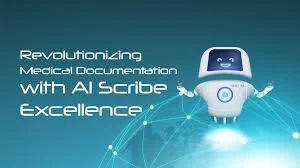🤖 AI-Powered Scribes in India: Job Threat or Evolution in Healthcare?
🧬 Introduction: Scribing in the Age of Machines
As healthcare digitizes, one question echoes through hospitals, BPOs, and training centers in India:
“Will AI replace medical scribes?”
The answer is not a simple yes or no.
AI tools like Augnito, Suki AI, and Nuance Dragon are changing how medical notes are created — but instead of eliminating scribes, they’re shifting their roles into smarter, more meaningful domains.
This article explores:
-
How AI is impacting medical scribing in India
-
Which skills are now essential
-
What jobs are evolving — and disappearing
-
What young scribes should do today to stay ahead
📍 What Is an AI-Powered Scribe?
An AI scribe:
-
Uses voice recognition and NLP (Natural Language Processing)
-
Converts doctor-patient conversation into structured medical notes
-
Integrates directly with Electronic Health Records (EHR)
Tools like:
-
Suki AI — US-based, used by primary care physicians
-
Augnito — India’s own real-time voice AI tool
-
Dragon Medical One — Enterprise-grade scribing AI
They don’t remove scribes — they make them faster.
💼 What Changes for Indian Scribes?
| Old Scribe Role | New AI-Aware Scribe Role |
|---|---|
| Typing entire visit manually | Editing AI-drafted notes |
| Passive listening | Active real-time documentation QA |
| One doctor, one scribe | Scribes manage 2–3 doctors efficiently |
| No tech knowledge | Basic AI/NLP tool handling required |
| Language skills only | Medical terminology + tech integration |
🇮🇳 Why India Is Becoming the Hub for AI-Integrated Scribes
📊 Key Drivers:
-
🇮🇳 Large English-speaking scribe workforce
-
🧠 BPO roots — trained in compliance, SOPs, HIPAA standards
-
🏥 US hospital demand — looking to cut costs and improve accuracy
-
🎓 Edtech training boom — institutions now teaching AI + Scribing
Result:
India is becoming not just a backend, but the center for intelligent medical documentation.
🧠 Skills That Are In, and What’s Out
✔️ Skills in High Demand:
-
Medical transcription + understanding of US clinical terminology
-
Basic AI interface handling (Augnito, Suki dashboards)
-
QA review logic: spotting errors AI might miss
-
Ability to summarize SOAP notes fast
-
Remote work ethics + night shift adaptability
❌ Skills Going Outdated:
-
Manual note writing
-
Dependency on single specialty
-
Refusal to adapt to AI
-
Poor communication with physicians over digital channels
“Adaptation is no longer a bonus — it’s job security.”
🏥 Real-Life Case: From Typist to AI Workflow Manager
Swathi, 27, was a medical scribe in Hyderabad handling orthopedic notes.
When AI was introduced in her workflow:
-
She was given basic training on Suki’s interface
-
Instead of typing, she learned to review, edit, and validate real-time notes
-
Today, she manages 3 physicians simultaneously and earns 45% more than she did earlier
“AI didn't steal my job. It promoted me. Now I’m a trainer too.”
💻 Remote Work Surge: AI + Scribes From Home
Post-COVID, 90% of Indian scribes now work remotely.
🔄 Hybrid workflow:
-
Doctor uses voice-to-AI input
-
Draft note is generated
-
Indian scribe QA edits + uploads to EHR
-
Turnaround time: <10 minutes
Many companies now hire:
-
Freelance scribes
-
Contract-based AI documentation editors
-
Shift-based virtual assistants with medical knowledge
🔬 The Future: Coexistence, Not Competition
AI can:
-
Draft
-
Suggest templates
-
Auto-complete common phrases
But it cannot:
-
Contextualize patient complexity
-
Understand local slang, mixed languages
-
Interpret emotional cues
-
Take legal responsibility for final notes
Hence, AI and scribes will co-exist, creating smarter, faster documentation teams.
🔗 Internal Links (MediOwlScript)
📢 Social CTAs
💬 Comment below:
“Are you ready to work with AI, or still afraid of it?”
📲 Follow MediOwlScript:
-
Instagram: @mediowlscript
-
Facebook: MediOwlScript
-
X/Twitter: @MediOwlScript
📩 Use hashtags:
#AIMedicalScribe #HealthcareJobsIndia #MediOwlScript

Comments
Post a Comment